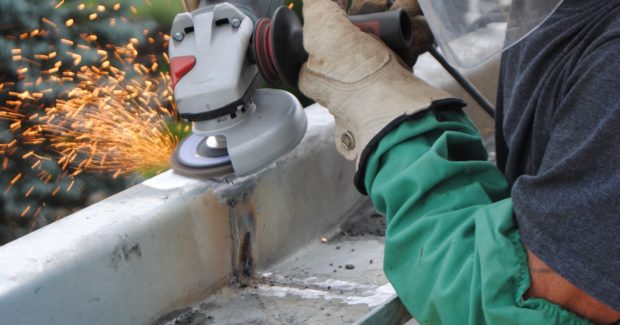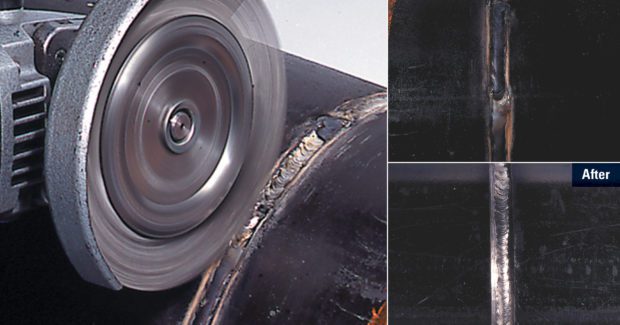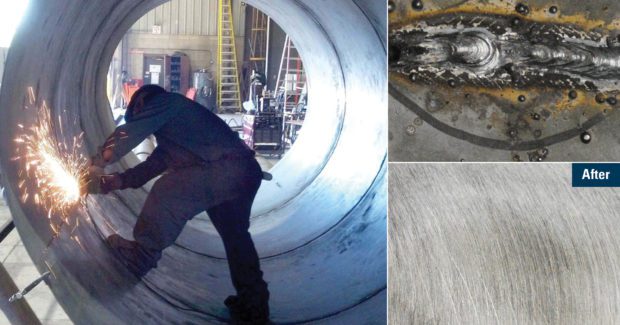Tips for Choosing the Right Product for Welding and Fabrication Surface Finishing
Here are some insights on how to address the varying levels of surface finishing requirements that depend on industry demands and the eventual end use of the finished product.
Posted: October 25, 2016
Proper surface cleaning and finishing of welded materials is critical to productivity, efficiency and safety in many industries, including food production, pressure vessels, power generation, shipbuilding and transmission pipeline building to name a few. There are varying levels of surface finishing requirements depending on industry demands and the eventual end use of the finished product. For the purposes of our discussion here, most of the focus will be directed at before, during and after the welding process. We will not address surface profile measurements or surface roughness parameters. Choosing the right product for surface finishing applications is important to meeting the application requirements. They can enhance an operator’s productivity while also reducing the risk of cross-contamination that could lead to rework.
THE SPECTRUM OF SURFACE FINISHING
Surface finishing is a broad spectrum with different definitions depending on the industry, covering application requirements that range from critical to noncritical and everything in between. For example, the most critical applications often require welds to be 100 percent inspected utilizing X-ray or ultrasound to ensure complete penetration for structural safety reasons. Examples of this include pressure vessels and oil and gas transmission pipelines. Welds in these applications are cleaned between passes to remove all inclusions, which, if not removed, could cause safety hazards or even catastrophic weld failure.
In food production, internal welds are ground smooth in many cases to eliminate inconsistencies or crevices where bacteria could possibly grow. Similarly, finished products such as handrails cannot have sharp edges where human contact is expected. These would be considered as having important surface requirements, but not critical structural weld finish requirements. When the finish does not need to meet safety requirements and the focus is purely on cosmetic appearance, it is a noncritical application. However, just because the weld finish may be considered noncritical, that does not mean it is not important. Often, there is a high cost to rework, which still must be done if welds are not cleaned properly the first time.
CHOOSING THE RIGHT PRODUCT
Understanding the requirements of the application and the base material – and the eventual end use of the finished product – are key factors in choosing the right product for the application. Are there specific industry codes that must be followed? How will the final product be used? Different products leave different finishes. Make sure the chosen product can produce the desired results. Grinding wheels, for example, are great for removing a lot of material, but they will commonly leave a rougher finish than other product options. Although there are many products to choose from when considering the varied needs for surface preparation, here are five common product categories. These are used in metalworking surface preparation and weld prep and finishing, in order from most to least aggressive:
- Abrasive grinding wheels: Grinding wheels – which are on the more aggressive end of the product spectrum and not traditionally thought of as a finishing product – are capable of removing a lot of material quickly when that is a priority. Even though they don’t typically leave a smooth surface finish, this condition may be acceptable in some applications, which is how they earn a spot on this list.
- Coated abrasives: These products cover a wide range that can include a number of converted products such as flap discs, flapper wheels, resin fiber discs and belts. They produce different surface finishes depending on the grit type and size, as well as other factors such as the operator, additional cooling top coats, different coating densities and the type of tool they are used on. They typically range from coarse grit to fine grit, with the finer grit removing less material but leaving a smoother finish. Flap discs are a good option that combine the aggression of a grinding wheel and the finishing characteristics of a resin fiber disc, making them a great multi-use product.
- Non-woven abrasives: Typical products include surface conditioning discs, belts, blending discs, convolute wheels, unitized wheels and hand pads. Non-woven abrasives consist of fibers that are permeated with abrasive grains and tend to be more flexible and forgiving than coated products. They also tend to leave a finer surface finish, so they are frequently used to create decorative finishes ranging from satin to near-mirror polish. Within this category, products range from coarse to ultra-fine.
- Buffing wheels: Buffing wheels, typically made of cotton fiber, fall on the least aggressive end of the spectrum. Buffing wheels typically do not contain any abrasive material, though they are often used with compounds, waxes or other products that include very fine abrasives to remove slight surface scratches or to achieve a mirror finish.
- Power wire brushes: One of the unique features of wire brushes compared to abrasives products is that they clean base material rather than removing it, making them an excellent choice when maintaining part geometry is critical. Also, because the wire ends do the work and act like thousands of peening hammers, the resulting finish is a dull “orange peel” rather than a shiny scratched surface typical of an abrasive. Wire brushes are also great at cleaning hot welds that may cause glazing or melt some products in the abrasives category. Wire brushes are available in many different styles and sizes, including wheels, cups and end brushes.
Within each product category, there are different types available to produce different surface finish results on different types of base materials. The stricter the surface finish requirement, the more homework that should be done to determine the best product to meet the application needs. Also keep in mind, it may take a combination of products to reach the desired surface finish. Always start with the most aggressive product that is acceptable for the application first and step the way down. This will allow for more efficiency.
MATCH THE MATERIAL
While the surface finish requirements of the application are among the most important factors in choosing products, it’s also important to match the finishing product to the surface material. The three most common materials used in welding and fabrication are steel, stainless steel and aluminum. Steel is by far the most common material used in applications across industries such as heavy equipment manufacturing, and most surface finishing products work well with this material. The food production industry tends to use stainless steel, and shipbuilding and emergency vehicle markets are moving toward aluminum. When working with stainless steel or aluminum, look for a finishing product designed specifically for use on those materials.
Heat discoloration on stainless steel and “loading” or “gumming up” on product used on aluminum are two common concerns, especially when using more aggressive products that generate more heat and friction. Products designed for aluminum and stainless steel have top coats or additives to help prevent these problems. Also look for products that are designated as contaminant-free when working with these materials. In addition, be aware of the potential for cross-contamination with the finishing products. If one side of the shop is fabricating steel and the other side is fabricating stainless steel, keep separate products for each side. Many products are marked in some way to help the operator determine if they are for use on steel, stainless steel or aluminum.
BEST PRACTICES FOR SURFACE FINISHING
Following best practices can help operators achieve optimal results. Using these tips can minimize the risk of damage to the workpiece while also helping achieve the desired surface finish faster. When using a grinding wheel, one of the most important practices is to use it at the proper angle: typically 5 deg to 45 deg. The recommended angle will usually be labeled on the product. In addition, always start using a grinding wheel by gently touching the workpiece and pulling back rather than pushing down. Starting with a pullback motion results in the operator naturally holding the wheel flatter and lighter on the surface, helping to prevent gouging the workpiece during starts.
With a flap disc, the recommended angle depends on whether the operator is using a Type 29 (angled) disc or a Type 27 (flat) disc. Using a Type 29 disc at a 45 deg angle to the workpiece, for example, means the operator is only using the outside 1/4 in of the disc. Reducing the angle with that type of disc helps better utilize the whole width of the disc abrasive surface for improved efficiency. It’s also important to avoid lingering or “stalling” in one area of the workpiece with a finishing product mounted on a right angle grinder, especially when using a grinding wheel or a coarse coated abrasive. Less aggressive abrasive products are more forgiving of this, but it is always recommended to keep a consistent and fluid motion for the most consistent finish results. If an operator lingers with a grinding wheel in one area of the workpiece, for example, the wheel will gouge the surface almost immediately, whereas a stalled flap disc typically takes a little longer to gouge the surface.
Lastly, operators should avoid applying too much pressure when using any surface finishing product, as it can lead to a loss of control, slippage or sore and numb muscles at the end of a long day, potentially causing operator injury. Let the finishing product do the work.
SUCCESS IN SURFACE FINISHING
Proper surface finishing is a critical and necessary part of many welding and fabrication applications. Producing the desired results starts with choosing the right product for the job. It’s also important to follow the recommended best practices for use and selection based on the base material that will be finished, and any regulations and standards for the given industry. These key steps help operators improve productivity, reduce rework, and contribute to high-quality finished products that meet the necessary requirements of the end customer.














